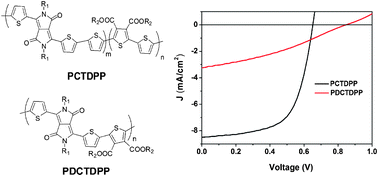Incorporation of ester groups into low band-gap diketopyrrolopyrrole containing polymers for solar cell applications
Abstract
To increase the open circuit voltage (VOC) of

* Corresponding authors
a
State Key Lab of Silicon Materials, MOE Key Laboratory of Macromolecule Synthesis and Functionalization, & Department of Polymer Science and Engineering, Zhejiang University, Hangzhou 310027, P. R. China
E-mail:
hzchen@zju.edu.cn
Fax: +86 571 87953733
Tel: +86 571 87952557
b
Department of Energy Conversion and Storage, Technical University of Denmark, Frederiksborgvej 399, DK-4000 Roskilde, Denmark
E-mail:
frkr@dtu.dk
Fax: +45 46774791
Tel: +45 46774799
To increase the open circuit voltage (VOC) of

 Please wait while we load your content...
Something went wrong. Try again?
Please wait while we load your content...
Something went wrong. Try again?
X. Hu, L. Zuo, W. Fu, T. T. Larsen-Olsen, M. Helgesen, E. Bundgaard, O. Hagemann, M. Shi, F. C. Krebs and H. Chen, J. Mater. Chem., 2012, 22, 15710 DOI: 10.1039/C2JM31700A
To request permission to reproduce material from this article, please go to the Copyright Clearance Center request page.
If you are an author contributing to an RSC publication, you do not need to request permission provided correct acknowledgement is given.
If you are the author of this article, you do not need to request permission to reproduce figures and diagrams provided correct acknowledgement is given. If you want to reproduce the whole article in a third-party publication (excluding your thesis/dissertation for which permission is not required) please go to the Copyright Clearance Center request page.
Read more about how to correctly acknowledge RSC content.
 Fetching data from CrossRef.
Fetching data from CrossRef.
This may take some time to load.
Loading related content
